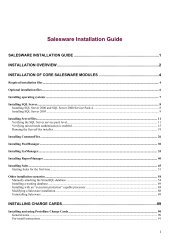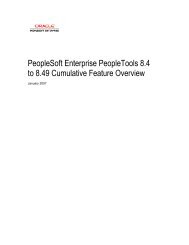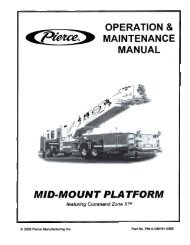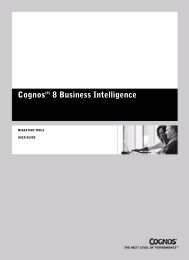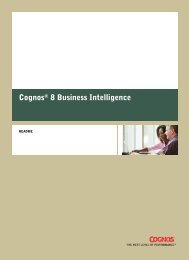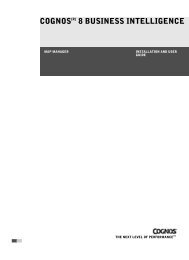COGNOS Business Intelligence Series 7
pes.pdf
pes.pdf
Create successful ePaper yourself
Turn your PDF publications into a flip-book with our unique Google optimized e-Paper software.
Chapter 2: Configure Servers<br />
Daemon<br />
UpfDispatcherService<br />
ncdispatcher<br />
ncserver<br />
ns-admin<br />
ns-slapd<br />
Scripts<br />
start-dispatcher<br />
stop-dispatcher<br />
By default, these scripts are located in the bin directory.<br />
start-ncdispatcher<br />
stop-ncdispatcher<br />
By default, these scripts are located in the bin directory<br />
start-ncserver<br />
stop-nc-server<br />
By default, these scripts are located in the bin directory<br />
start-admin<br />
stop-admin<br />
By default, these scripts are located in the directory where you<br />
installed Sun ONE Directory Server.<br />
start-slapd<br />
stop-slapd<br />
By default, these scripts are located in the slapd-alias directory.<br />
Instead of using these scripts, you can use the Web browser<br />
interface of Sun ONE Administration Server (ns-admin) to start<br />
and stop the directory server.<br />
Steps<br />
1. Locate the script you want to run.<br />
2. Run the script from a UNIX shell.<br />
Tip: You can also run UNIX scripts using the command line interface in Configuration<br />
Manager. For more information, see the Configuration Manager User Guide.<br />
PowerPlay Enterprise Server Cleanup<br />
On a gateway machine using CGI Temp mode (p. 109) for temporary file access, a service is<br />
required to delete old files on the machine. There is a UNIX and Windows utility that periodically<br />
removes these files.<br />
The CGI process creates and reads the temporary files. To enable automatic removal of these files,<br />
the PowerPlay Enterprise Server cleanup service can be invoked (Configuration Manager,<br />
Advanced Properties).<br />
If a PPES cleanup service is installed on the machine, it will periodically manage the cleanup of<br />
these temporary files.<br />
Check the Windows Environment Variables<br />
The Cognos PowerPlay Enterprise Server (cern) service uses system environment variables, not<br />
user environment variables.<br />
To check environment variables, use the Windows System Properties.<br />
Steps<br />
1. From the Windows Start menu, click Settings, Control Panel.<br />
2. Double-click System.<br />
3. Click the Advanced tab.<br />
Enterprise Server Guide 17




